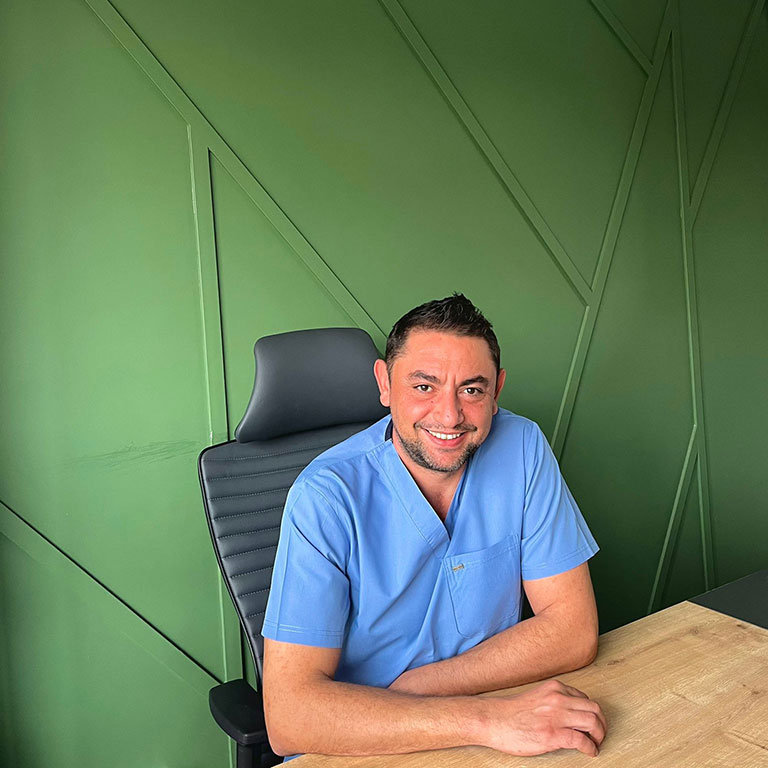

Prosthesis

Dental prostheses are all artificial materials prepared to restore the aesthetic appearance and functions of teeth lost in the mouth due to various reasons, such as chewing and speaking. In general, tooth and bone loss occurs as a result of not treating gum diseases. With prosthesis, lost oral health is restored. For this purpose, the lost lip, cheek support, speech function, chewing function and aesthetic appearance are regained. Psychological support is provided to individuals who have to live with missing or ruined teeth and have forgotten how to smile. It is aimed to improve people's quality of life with dental prostheses.
Prostheses, popularly called crowns or dentures, are artificial teeth made to replace teeth lost for various reasons or to eliminate aesthetic disorders, so that the person can perform chewing and speaking functions.
Prosthetics and especially crowns are used in the treatment of teeth with excessive material loss.
The purpose of prosthetic applications is to make artificial teeth that are compatible with the person's face and can perform chewing and speaking functions as closely as possible to nature.
Metal supported porcelain veneers
Metal-supported porcelain veneers, as the name suggests, are made by placing a metal alloy under the porcelain during the construction phase. They are porcelain veneers made using Chromium-Cobalt or Chromium-Nickel alloys that are compatible with the tooth tissue and have the required durability.
What is zirconium supported porcelain?
Zirconium-supported porcelain crowns are prostheses that use white-colored zirconium alloy instead of metal as the infrastructure.
Zirconium coatings,
- It has an aesthetic appearance very close to natural teeth.
- It is much more aesthetic than metal-supported coatings.
- Reflects light.
- Since white colored alloy is used as the substructure, no dark lines occur at the gum line.
- It is 100% compatible with the human body. It does not cause allergic reactions.
Laminate Veneer
Laminates, which are produced from porcelain with a very thin design by strengthening their physical structure, are generally applied to the front teeth. Lamina, which means "leaf" in Latin, allows the creation of excellent aesthetic appearances with its leaf-like thin structure. Laminate dental applications, in which the dental tissue is lost to a minimum, are performed without cutting the teeth and by thinning only the front surfaces by 0.3 to 0.7 mm. The procedure, which is applied by gluing the teeth on thinned front surfaces, can be applied for many different purposes.
- Deformed teeth
- Teeth with severe color changes that do not improve despite whitening,
- Repair of old fillings whose form and color are damaged
- In joining separate teeth
- Correction of crooked and crooked teeth,
- Laminate dental treatment can be applied to restore broken or worn teeth.
Laminate teeth, or in other words, leaf porcelain application, which can be applied to individuals of almost all ages, cannot be applied to people with jaw disorders, pencil-biting, nail-biting habits, and individuals with severely receding gums. If there is no need for any treatment for the gums or if there is no aesthetic intervention, laminate dental application can be completed with treatments lasting 2-3 sessions.
When should an orthodontic examination be performed?
Sometimes an orthodontic examination at the age of 5-6 can be useful. Orthodontic treatment is not performed at this age, but some precautions can be taken. These are defined as preventive and preventive orthodontic treatments.
DENTAL PROSTHESIS TYPES
Fixed Dental Prostheses
Adhesive dental prostheses such as crowns and bridges that the patient does not remove himself.
These are prostheses that replace the visible parts of the teeth in the mouth and cannot be removed by the patient. They may also be called veneers or porcelain teeth.
Fixed prostheses are used for the restoration of teeth with excessive material loss due to decay or any other reason, teeth that are colored and whose color cannot be restored, and teeth with deformities. Teeth are shaped to be veneered.
Then, the measurement is taken and it is prepared in the laboratories in accordance with the instructions of your physician. After the rehearsals are made, your coating is adhered and the process is completed. Caring for veneers should be done in the same way as caring for healthy teeth. A well-made crown should be no different from a healthy tooth in terms of function and cleaning. In the construction of these teeth, porcelain, precious metal combinations, special glass materials and special plastics are made according to the selection of your physician.p>
Bridges, on the other hand, are prostheses made by taking support from other adjacent teeth in order to replace missing teeth. In the construction of these restorations, abrasions are made on both adjacent teeth and the bridge made connects all the teeth together. If a bridge is not made to replace the missing teeth, the patient's neighboring teeth and the opposing tooth in the other jaw will move towards the extraction space. Therefore, impaired tooth closure leads to caries and tooth loss. As with the veneer, the teeth to be taken as support are shaped by your dentist and the same procedures are performed. In addition to routine maintenance procedures, the maintenance of your veneers is done by cleaning the lower part of the piece placed in the gap with special Dental Pross as directed by your dentist.
Removable Dental Prostheses
These are dental prostheses that the patient can put on and take off whenever he wants. Removable dentures are dentures made to replace tooth loss that cannot be made into fixed dentures. Unlike fixed dentures, they can be inserted and removed. They are made from special plastic or metal-plastic combinations. It is done to ensure aesthetics and function. Since there are many missing teeth in cases requiring removable dentures, it must be done to fulfill the chewing function and to prevent damage to the other remaining teeth. Removable dentures are made in cases where all or most of the teeth are lost. In removable dentures, the metal hooks used to hold the denture to the natural teeth in the mouth are called "Crochets". Many people are uncomfortable with the appearance of these metals in their mouths. However, developing dentistry technology offers us a much more aesthetic solution in this regard. By using "Precision Retainers" or atelescope crowns, it is ensured that it adheres to the teeth, while preventing the appearance of the metal clasp from spoiling the aesthetics.
The first month of removable dentures is an adaptation period in terms of performing chewing and speaking functions. In addition, any incompatibilities (impacts) that may occur with the prosthesis should be eliminated by checks.
- Total Dental Prosthesis: Applied to mouths where all teeth are missing.
- Partial Dental Prostheses: Applied to partially toothless mouths. Retention is provided by nails and hooks on the teeth.
- Dental Prostheses with Precision Retainers: Applied to partially toothless mouths. They are aesthetic dental prostheses that do not have any externally visible apparatus, such as a hook.
Implant Prostheses
- Fixed: Bridges or crowns made with support from the implant.
- Movable: These are total-like prostheses made with support from implants, which are preferred in mouths with inadequate bone support.
All these methods have advantages and disadvantages. Your dentist is your biggest helper in deciding which method is most suitable for you.








